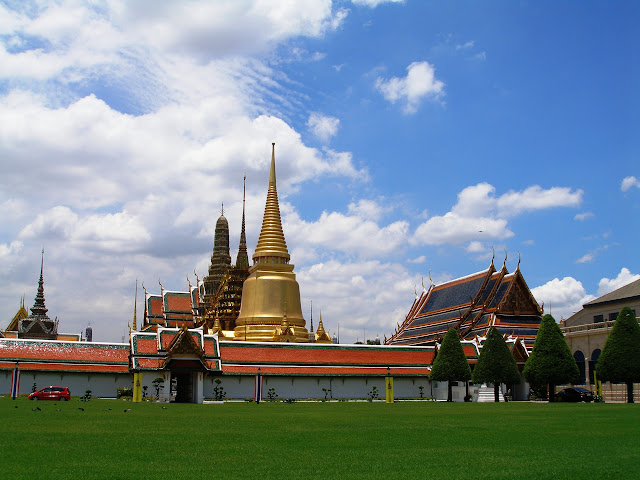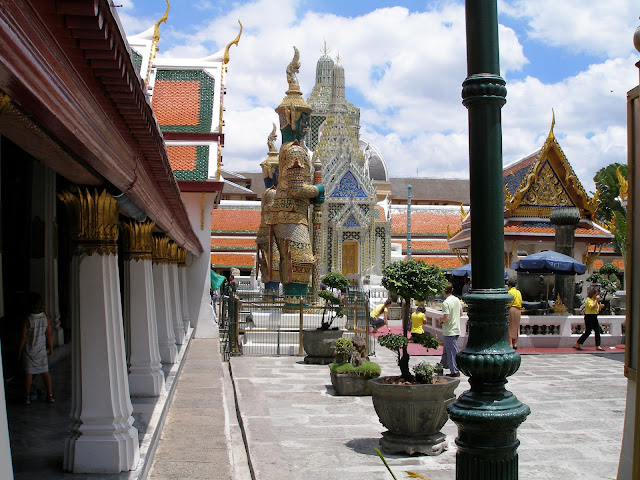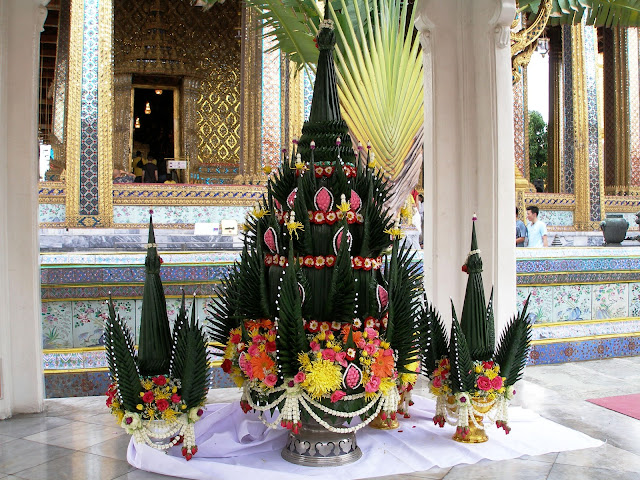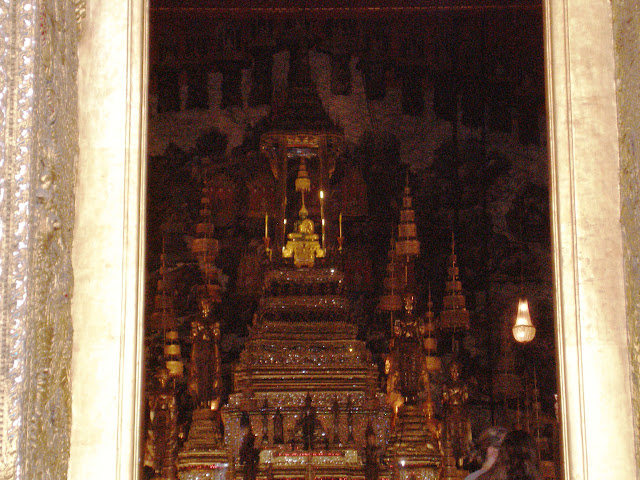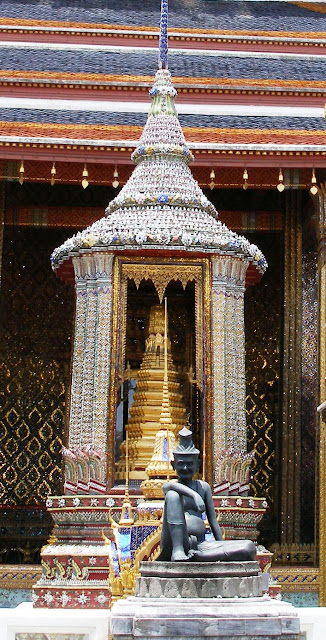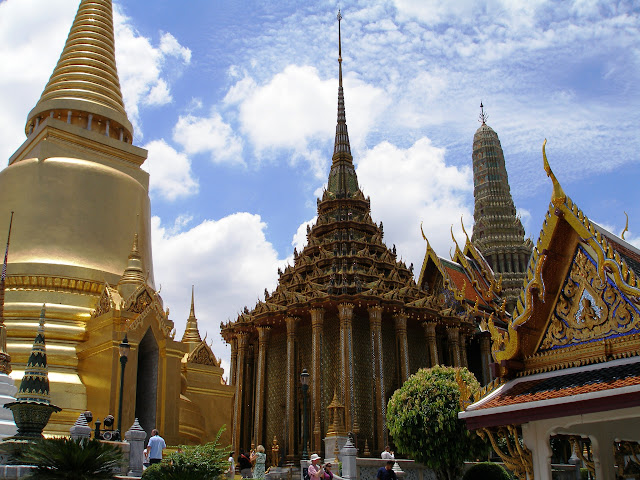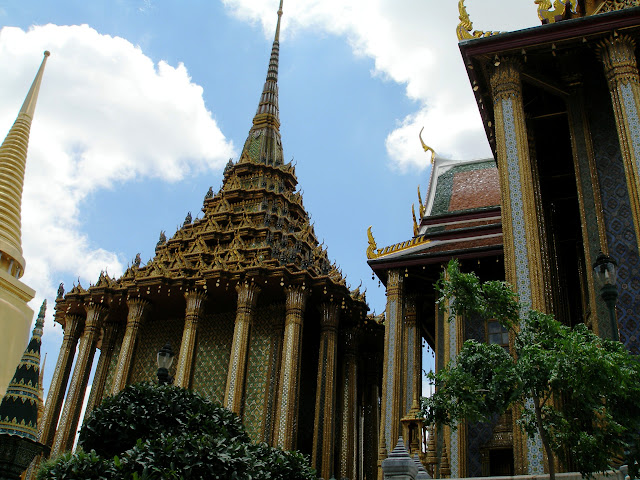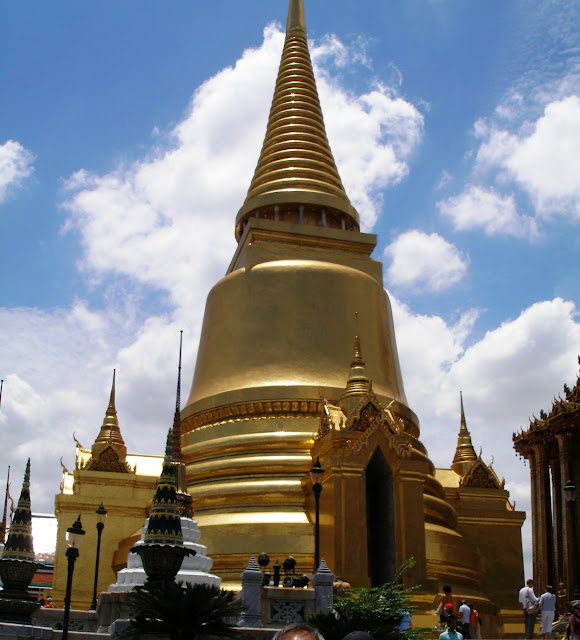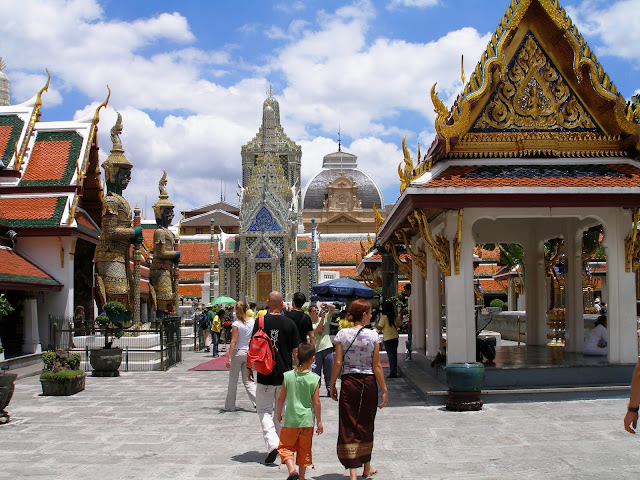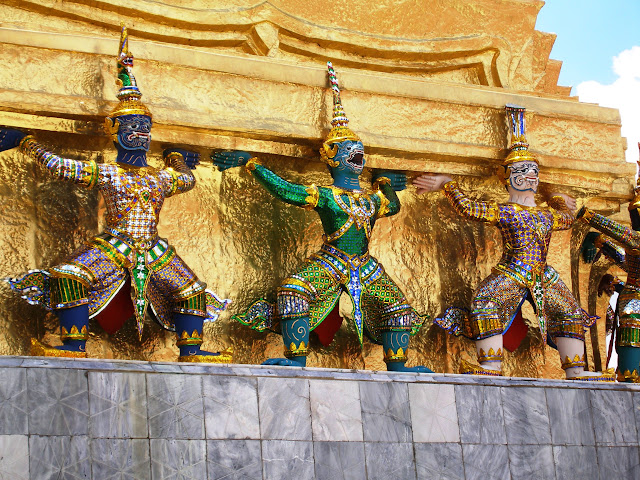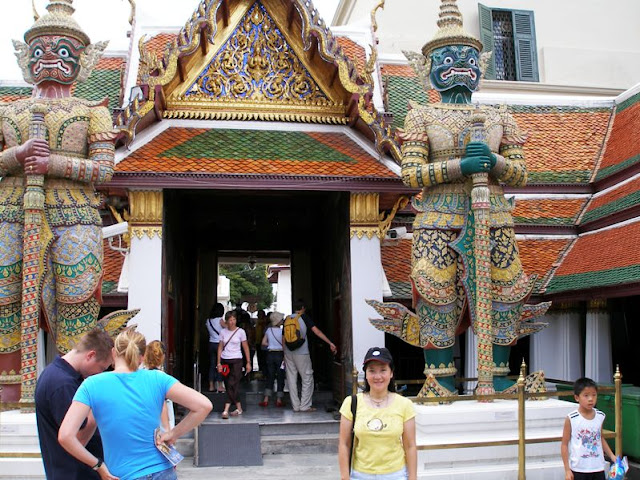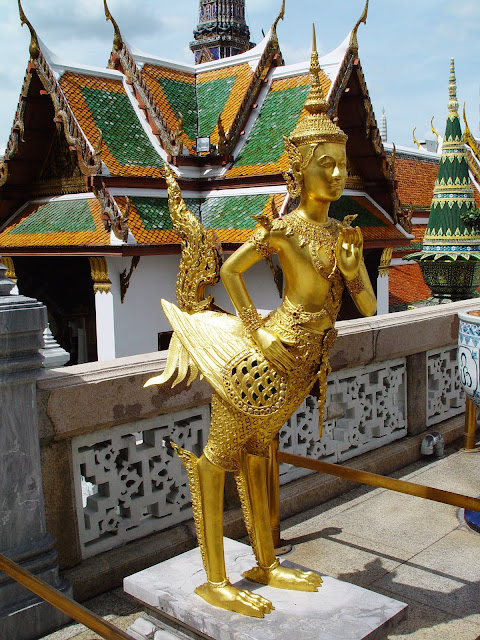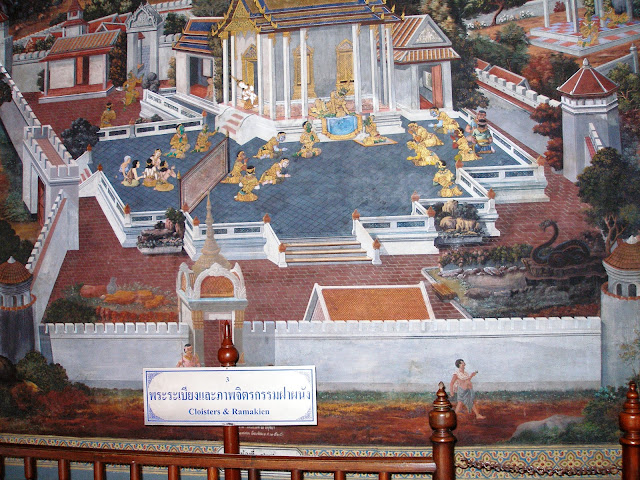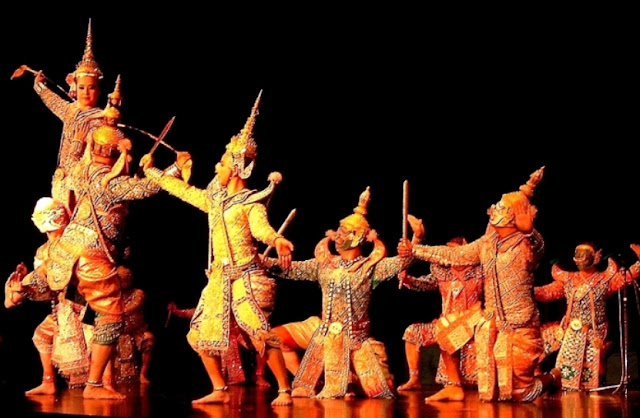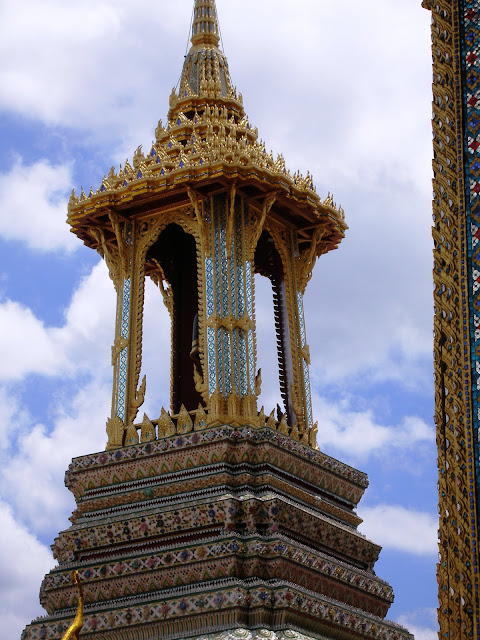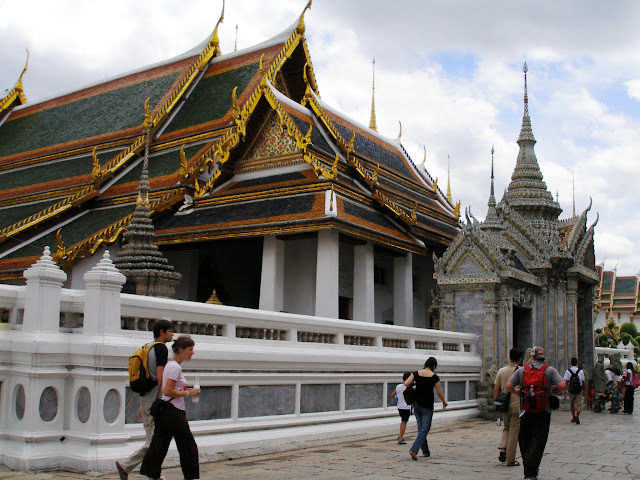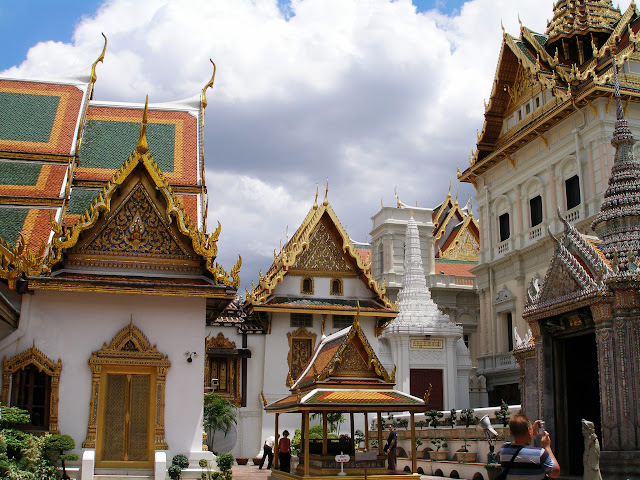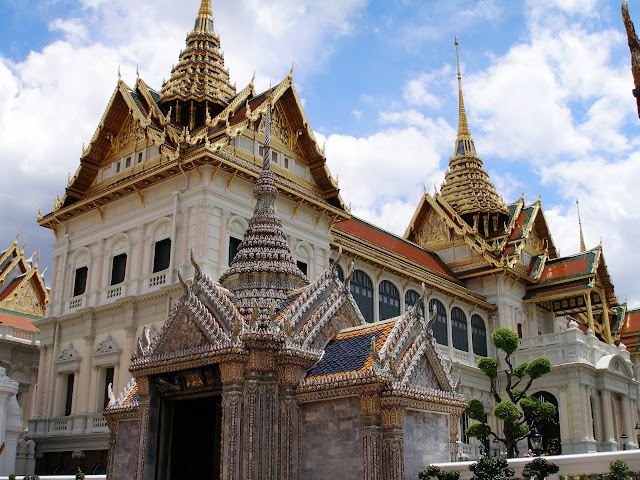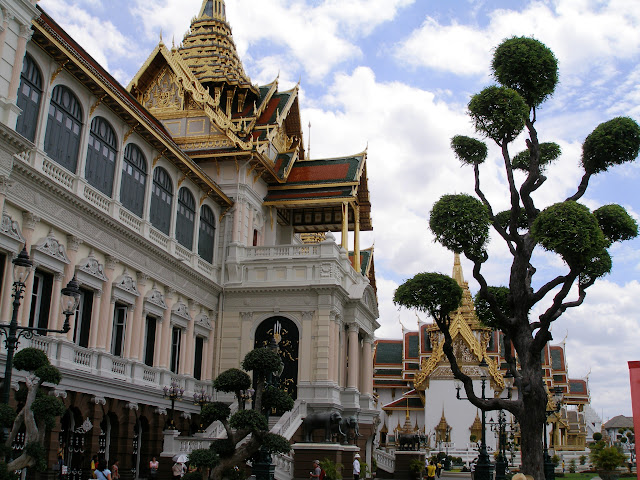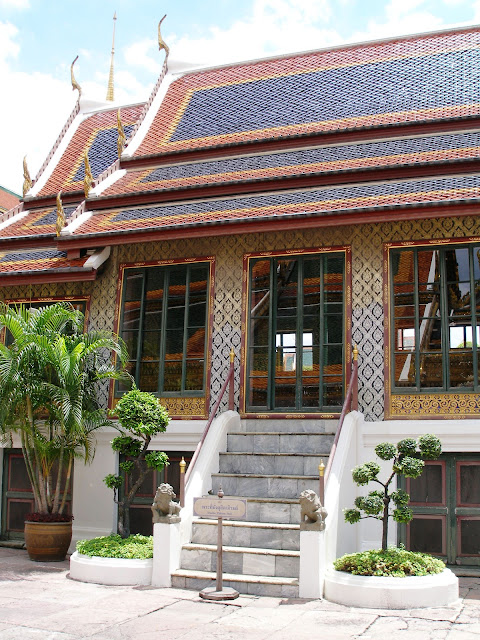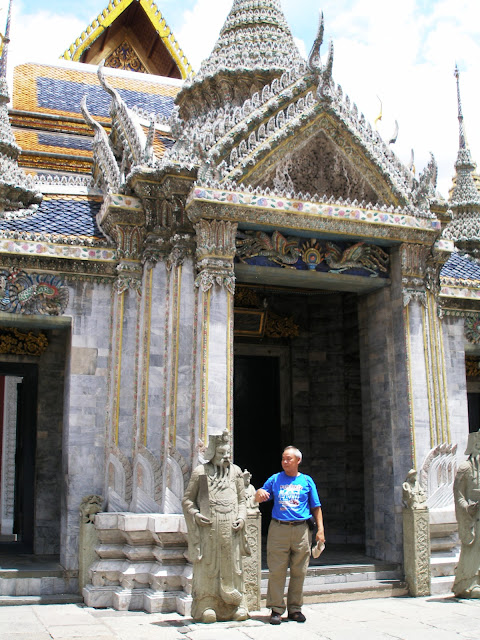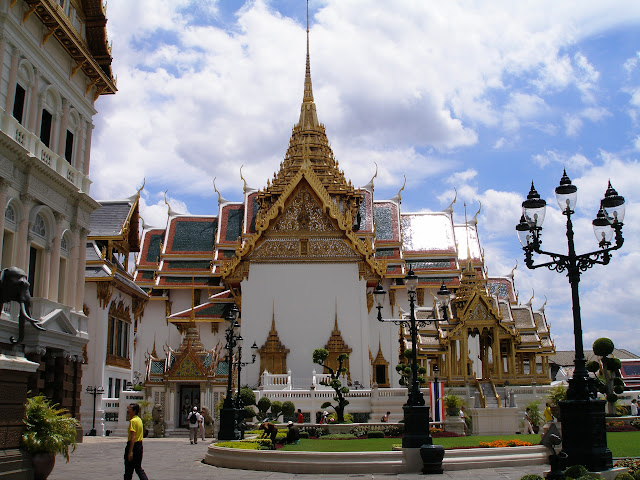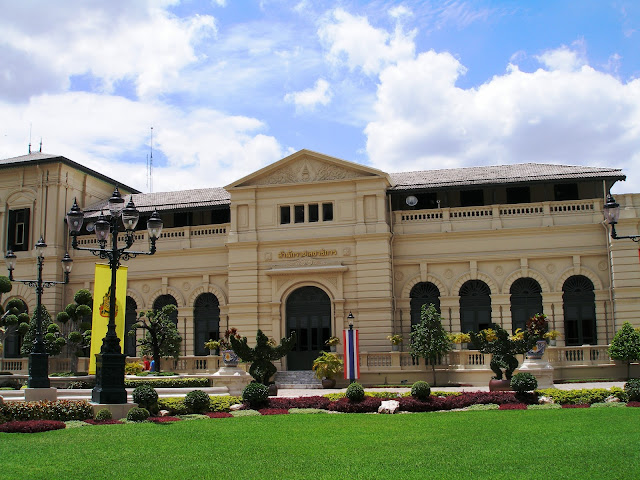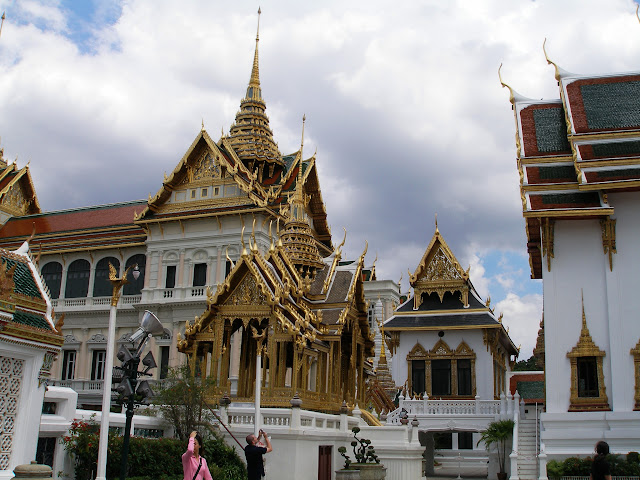View of The Wat Phra Kaew Complex and Temple Complex of the Emerald Buddha.
The Wat Phra Kaew (Temple of the Emerald Buddha) is regarded as the most sacred Buddhist temple (wat) in Thailand. The temple does not house any monks. Rather, it is more like the personal chapel of the royal family. It is located in the historic center of Bangkok within the precincts of the Grand Palace.
View of Pagodas and Temple inside the complex from the balcony of Emerald Buddha Temple.
The main attractions are the Ramakien Cloisters, the Chinese stone carvings, the statues of the mythological beings from the Himavamsa Forest, the Royal Pantheon [ Prasat Phra Thep Bidorn ], the row of eight prangs, the library [ Phra Mondrop ], the Emerald Buddha Temple [ Ubosoth ], the Chedi, and the various exteriors and art works.
The Temple is a complex surrounded by cloisters within which are buildings for diverse purposes and in different styles, yet all in Thai style.
Wat Phra Kaew contains the finest examples of Rattanakosin art and architecture. It is the finest art and architecture site in Thailand.
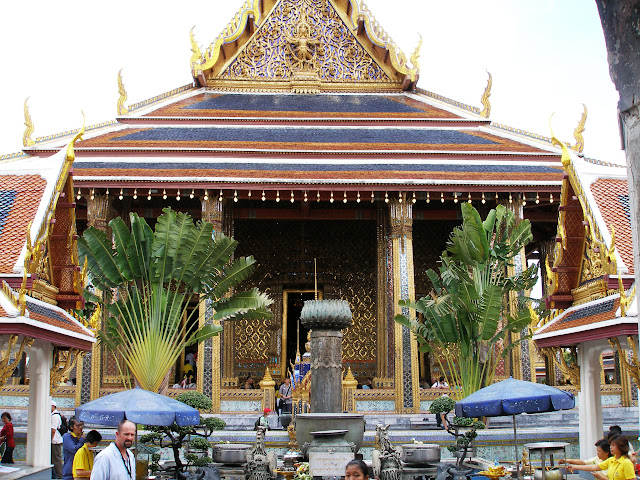
Temple of the Emerald Buddha.
The main building is the central ubosoth (a building in a Buddhist Wat. It is the holiest prayer room, also called the "ordination hall" as it is where ordinations take place), which houses the statue of Emerald Buddha.
Flowers arrangement offering in front of the Emerald Buddha Temple. The Temple of the Emerald Buddha sits within the grounds of the Bangkok Grand Palace, surrounded by walls more than a mile long. Inside, it contains some of the finest examples of Buddhist sculpture, architecture, painting, and decorative craft in Thailand.
The Emerald Buddha.
The lap of the Emerald Buddha is 48.3 cm. wide and the height, including the base, is 66 cm. The image is in a seated position, with the right leg resting on the left one.
Except for the Thai King, no other person is allowed to touch the statue. The King changes the cloak around the statue three times a year, corresponding to the summer, winter, and rainy seasons, an important ritual performed to usher good fortune to the country during each season.
According to the legend, the Emerald Buddha was created in India in 43 BC by Nagasena in the city of Pataliputra (today's Patna). The legends state that after remaining in Pataliputra for three hundred years, it was taken to Sri Lanka to save it from a civil war. In 457, King Anuruth of Burma sent a mission to Ceylon to ask for Buddhist scriptures and the Emerald Buddha, in order to support Buddhism in his country. These requests were granted, but the ship lost its way in a storm during the return voyage and landed in Cambodia.
When the Thais captured Angkor Wat in 1432, the Emerald Buddha was taken to Ayutthaya, Kamphaeng Phet, Laos and finally Chiang Rai, where the ruler of the city hid it. Cambodian historians recorded capture of the Buddha statue in their famous Preah Ko Preah Keo legend. However, some art historians describe the Emerald Buddha as belonging to the Chiang Saen Style of the 15th Century AD, which would mean it is actually of Lannathai origin.

Historical sources indicate that the statue surfaced in northern Thailand in the Lannathai kingdom in 1434. One account of its discovery tells that lightning struck a pagoda in a temple in Chiang Rai, after which, something became visible beneath the stucco. The Buddha was dug out, and the people believed the figurine to be made of emerald, hence its name. King Sam Fang Kaen of Lannathai wanted it in his capital, Chiang Mai, but the elephant carrying it insisted, on three separate occasions, ongoing instead to Lampang. This was taken as a divine sign and the Emerald Buddha stayed in Lampang until 1468, when it was finally moved to Chiang Mai, where it was kept at Wat Chedi Luang.

The Emerald Buddha remained in Chiang Mai until 1552, when it was taken to Luang Prabang, then the capital of the Lao kingdom of Lan Xang. Some years earlier, the crown prince of Lan Xang, Setthathirath, had been invited to occupy the vacant throne of Lannathai. However, Prince Setthathirath also became king of Lan Xang when his father, Photisarath, died. He returned home, taking the revered Buddha figure with him. In 1564, King Setthathirath moved it to his new capital at Vientiane (capital of Laos).
In 1779, the Thai General Chao Phraya Chakri put down an insurrection, captured Vientiane and returned the Emerald Buddha to Siam, taking it with him to Thonburi. After he became King Rama I of Thailand, he moved the Emerald Buddha with great ceremony to its current home in Wat Phra Kaew on March 22, 1784. It is now kept in the main building of the temple, the Ubosoth.
The Ubosoth of the Emerald Buddha is surrounded by eight Bai Sema housed in ornate shelters, typical of other ubosoths in Thailand.
The ubosoth is also surrounded by twelve salas (or open shelters), built during the reign of King Rama I in the 18th century. Scholars sat in the salas and recited the Jatakas(stories of previous lives of the Buddha) on important days in the Buddhist calendar. The tales were recited in relay from pavilion to pavilion.
King Rama Ill had a figure of a seated hermit, who was supposed to be a great physician, cast in bronze. A bronze figure is situated behind the ubosoth of the Emerald Buddha. A grinding stone and a mortar were placed before the figure so that people could come to worship and grind their medicine symbolically for greater efficiency. Again, the traditional offerings of incense sticks, candles and lotus buds were offered to the statue of the holy hermit.
Phra Si Ratana Chedi is on the left and Phra Mondop, the library is in the middle of picture.
Another view of Phra Si Ratana Chedi from the courtyard
Phra Mondop, the library. King Rama I built a library in Thai style, in the middle of the complex, known as the "Phra Mondop". The library houses an elegantly carved Ayutthaya-style mother-of-pearl doors, bookcases with the Tripitaka (sacred Buddhist manuscripts), human-and dragon-headed nagas (snakes), and images of Chakri kings. I was told that it never opens to public.
Phra Sri Rattana Chedi [ Pagodas (Chedi) ]. in Sri Lankan style. The temple grounds also depict three pagodas to its immediate north, which represent the changing centers of Buddhist influence. One such shrine to the west of the temple is the Phra Si Ratana Chedi, a 19th-century stupa built in Sri Lankan style enshrining ashes of the Buddha.
Beautiful landscape with Chinese figurine in front of the temple
Courtyard in the middle of Wat Phra Kaew (Temple of the Emerald Buddha). A pair of yaksah on the left is standing guard at the entrance gate. Ho Phra Khanthararat (Chapel of the Gandhara Buddha Image) is in the middle of the picture and a sala is on the right.
Two Golden Gilt Chedis, (Chedi mean pagoda) situated in front of Prasat Phra thep Bidorn (Royal Pantheon) were constructed by King Rama 1 in honor of his father (southern pagoda) and mother (northern pagoda). Two Golden Gilt Chedis are exactly the same design and size, having a square base with triple indented corners. The structures are entirely covered with copper sheets, painted with lacquer and covered with gold leaf.
The Golden Gilt Chedis are placed on an octagonal base lined with marble adorned with a cross design. Above the base are 20 plaster Yaksah and monkeys decorated with colored glass that appear to be lifting the chedi. A monkey figure is placed at the center of each side of the base.
The entire temple is enclosed by a covered gallery, the outer wall of which is painted with elaborate scenes from the Ramakien epic. Each entrance is guarded by a pair of huge demons called yaksah.
In Buddhist mythology, the yakṣah are the attendants of Vaiśravaṇa, the Guardian of the Northern Quarter, a beneficent god who protects the righteous. In Thai, Yaksah is a male form and Yaksih is a female form.
Kinnara.
In Buddhist mythology and Hindu mythology, a kinnara is a paradigmatic lover, a celestial musician, half-human and half-bird (south-east Asia). The Kinnari in Thai literature originates from India, but was modified to fit in with the Thai way of thinking. The Thai Kinnari is depicted as a young woman wearing an angel-like costume. The lower part of the body is similar to a bird, and should enable her to fly between the human and the mystical worlds. The male counterpart of the female Kinnari is a Kinnon.
Ramakien Cloisters.
The Ramakian is the Thai version of the Indian Hindu epic written over 2,000 years ago, '' Ramayana ''. The Ramayana is a long and complex epic concerning the reincarnation on earth of the Hindu God Vishnu. The epic was introduced throughout South East Asia during the Indianization of the region and features in the theatrical, dance and decorative arts of the region including, Bali, Java and Cambodia as well as in Thailand
The Thai Ramakian version was written in the reign of King Rama 1 at which time the 178 large panels of murals at the Emerald Buddha Temple were commenced. The purpose of the epic and also the murals is to exemplify the virtues in easily comprehended fashion
The Ramakien has become a firm component of the culture since its introduction to the Thai people. Though many consider it only an adaptation of a strange work from an archaic system of beliefs, it is firmly embedded in the cultural history of the country and the people. The Ramakien of Rama I is considered one of the masterpieces of the Thai literature. It is still read, and is taught in the country's schools.
Prasat Phra Thep Bidon (Royal Pantheon).
The construction of the Royal Pantheon commenced in the year 1855, the first year of King Rama IV's reign. He intended to use it for the enshrinement of the Emerald Buddha. However, it was not completed until after his death, and his successor, King Rama V, did not move the palladium to the new building which he considered too small to accommodate the congregation at royal ceremonies. A Small gilt stupa belonging to King Rama IV was placed there instead.
Prasat Phra Thep Bidon (Royal Pantheon) is noted for its eye-catching gilt lacquer angel-motif designs on the outer panels of the doors and windows, and for the decorative motif based on the emblems of each of the first five sovereigns of the Dynasty on the side panels of the outer recesses of the doors and windows. On the lintels are stucco gold designs composed of royal decorations.
The Belfry (Ho Rakhang).
King Rama I built a belfry in the Royal Chapel compound for the bell that he brought from another temple either from Wat Saket in Bangkok or Wat Rakhang in Thon Buri) at the beginning of his reign. The structure now seen was designed and built in the reign of King Rama IV.
The lower part of the belfry is a square redented structure housing the stairway to the graceful spire-roofed throne at the top. The bell is renowned for the beauty of its resonance which is said to be unrivalled by any other bell in the whole kingdom. It is rung only on state occasions.
Ho Phra Khanthararat (Chapel of the Gandhara Buddha Image).
Situated in the eastern corner of the Royal Chapel compound, the small Chapel of the Gandhara Buddha comprises two structures built on the same base. It was constructed in the mid-19th century By King Rama IV. In the superstructure of the building at the back, an ancient gilt stupa, brought down from the North by the same king, was reposited. The front edifice houses a Buddha image known as the Gandhara Buddha.
The gate led to the Grand Palace and the inner wall divides the Wat Phra Kaew and the Grand Palace. Phra Maha Monthain located next to the wall.
The Grand Palace
The Grand Palace has an area of 218,400 sq. meters and is surrounded by walls built in 1782. The length of the four walls is 1,900 meters. Within these walls are situated government offices and the Chapel Royal of the Emerald Buddha besides the royal residences.
When Siam restored law and order after the fall of Ayutthaya the monarch lived in Thonburi on the west side of the river. Rama I, on ascending the throne, moved the center of administration to this side of the Chao Phraya; and, after erecting public monuments such as fortifications and monasteries, built a palace to serve not only as his residence but also his office’s--the various ministries, only one of which remains in the palace walls.
This palace came to be known as the Grand Palace, in which the earliest edifices contemporary with the foundation of Bangkok were the two groups of residences named the Dusit Maha Prasat and the Phra Maha Monthian.
Chakri Maha Prasat Hall.
The Chakri Group was built and resided in by King Chulalongkorn, Rama V (1868-1910). Only the reception portion is now used, consisting of two wings for reception purposes decorated with galleries of portraiture. In between is the central throne-hall now used for various purposes and formerly for the reception of foreign envoys on the occasions of the presentation of their credentials. It is aptly decorated with four canvasses of diplomatic receptions.

Chakri Maha Prasat Hall. One on the right as one enters depicts the reception by Queen Victoria of King Mongkut's ambassador in London, further on Louis XIV's reception of the mission sent by King Narai of Ayutthaya in the Galleries des Glaces in the Palace of Versailles; a third, on the other side of the room, King Mongkut's reception of the French Envoy, and the fourth of the reception at Fontainebleau by the Emperor Napoleon III of another Siamese Mission. The crystal decorations of the hall are mostly presents from foreign monarchs to King Chulalongkorn. By the side of the inner grand staircase is the dining hall attached to the building.
Dusida Phirom Hall
The entrance to the Amarindra Winitchai Hall, a portion of Phra Maha Monthian.
Inside the Grand Palace ground compound.
Secretary Office Building inside the Grand Palace complex.
Inside the Grand Palace ground compound.
Aphorn Phimok Prasat Pavilion and Chakri Maha Prasat Hall in the background
Sala is on the left , Aphorn Phimok Prasat Pavilion, Chakri Maha Prasat and Dusit Maha Prasat is on the right of the picture.
Dusit Maha Prasat Hall.
King Rama I built the Dusit Maha Prasat as a replacement for an earlier wooden Phra Thinang Amarintharapisek Maha Prasat which burned down in 1790. King Rama I intended that the present building be used for his own Lying-in-State as it has the same height and dimensions as the Phra Thinang Suriyamarin at Ayutthaya, the customary hall for the Lying-in-State of Ayutthaya kings.
Thus the principle function of the Dusit Maha Prasat has been and still is a Hall for Lying-in-State of kings, queens and honored members of the royal family. This Hall is also used for the annual Consecration Day Ceremony (Phra Ratcha Phithi Chat Mongkhon). It houses many important objects.
Getting to the Grand Palace and the Temple of the Emerald Buddha by boat from the Chaophraya River is easier than by land because you will avoid the famous dreadful Bangkok’s traffic jam unless you are with the tour bus. The Grand Palace is nowadays used only for occasional ceremonial purposes and is no longer the royal residence. Most of the Palace’s inner court closed to the public. The whole complex of the Temple and the Palace are coexisted with old traditional and European influence which are “a must see”. Highly recommend to at least a good guide book, or to find good tour guide to accommodate you for the trip, unless you just want to take a picture!
Note: Visitors must be properly dressed before being allowed entry to the temple. If you show up at the front gate improperly dressed, there is a booth near the entry that can provide clothes to cover you up properly.



 1:51 PM
1:51 PM
 KCCC
KCCC
